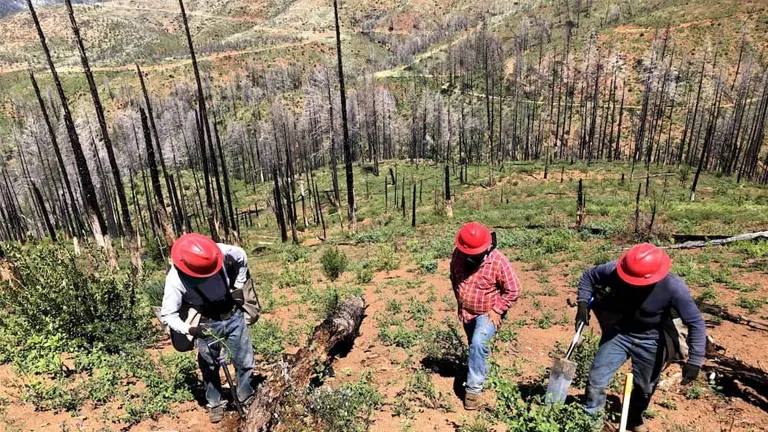5 Ways to Protect Our Forests
- September 25, 2023
- 0 comment
Forests have always held a special place in my heart. The towering trees, the peaceful serenity, and the vibrant biodiversity all come together to create a unique and vital ecosystem that we must cherish and protect. As someone who deeply cares about the environment, I’d like to share my top five ways to protect our precious forests. These are not just theoretical suggestions; they are actions I’ve taken to make a difference and you can too.

The first crucial step in protecting our forests is educating yourself. Once you know how to preserve them, you can inspire others to do the same. In this article, we’ll explore five ways to save our forests:
- Reduce, Reuse, Recycle
- Support Sustainable Forestry
- Participate in Reforestation Initiatives
- Advocate for Forest Conservation
- Practice Responsible Outdoor Recreation
Continue reading to discover valuable insights into safeguarding our precious forests.
The Importance of Healthy Forests
Nearly 2 billion individuals depend on the Earth’s forests as their primary source of sustenance. The absence of these formidable woodlands would result in the loss of essential provisions such as water, food, shelter, and income for these communities.
Moreover, trees exert a profound influence on the environment. Among their many vital functions, tree species serve as natural air purifiers and engage in direct combat against climate change. As atmospheric carbon dioxide levels escalate, dense forests act as carbon sinks, absorbing and converting CO2 into life-sustaining oxygen, thereby reducing air pollution.
For these compelling reasons, coupled with the intrinsic beauty of our planet, it is imperative to champion the cause of forest protection by adhering to the aforementioned recommendations. Acquiring the knowledge and adopting practices to conserve trees stands as one of the most impactful actions individuals can take to contribute to the well-being of our shared global environment.
1. Reduce, Reuse, Recycle
One of the simplest and most effective ways to protect our forests is by minimizing our carbon footprint. I’ve made it a point to reduce my waste and recycle diligently. By reducing the demand for new products, we can decrease the pressure on forests, which often suffer from logging and land conversion. I’ve also started reusing items whenever possible to reduce the consumption of resources that harm these natural habitats.

Importance of Forests
- Biodiversity Conservation: Forests are incredibly rich in biodiversity. They provide a habitat for countless plant and animal species. Many of these species are unique and can only be found in specific forest ecosystems. Forests serve as a genetic reservoir for a wide range of life forms, making them crucial for the conservation of Earth’s biodiversity.
- Climate Regulation: Forests play a pivotal role in regulating the Earth’s climate. They act as carbon sinks, absorbing and storing carbon dioxide (CO2) from the atmosphere. This helps mitigate the effects of climate change by reducing greenhouse gas levels. Forests also release oxygen through photosynthesis, which is essential for all aerobic life on Earth.
- Water Resources: Forests are like natural sponges that absorb rainwater, allowing it to percolate into the ground and replenish aquifers. They help regulate water flow in rivers and streams, preventing floods and droughts. Forested watersheds are vital for clean and reliable freshwater sources for both humans and wildlife.
- Soil Conservation: The root systems of trees and other vegetation in forests help bind the soil, preventing erosion. This is essential for maintaining soil fertility and preventing sedimentation in rivers and lakes. Healthy forests also contribute to the formation of rich, productive soils.
- Economic Benefits: Forests are a source of livelihood for millions of people worldwide. They provide timber, non-timber forest products (like nuts, fruits, and medicinal plants), and employment opportunities in forestry and related industries. Sustainable forest management practices ensure a continuous supply of these resources.
- Cultural and Recreational Value: Forests hold cultural and spiritual significance for many indigenous communities. They also offer recreational opportunities such as hiking, camping, birdwatching, and eco-tourism, contributing to our overall well-being and quality of life.
- Air Quality Improvement: Forests filter pollutants from the air, improving air quality in surrounding areas. They can help reduce the prevalence of respiratory diseases by acting as a natural air purification system.
- Research and Education: Forests provide a unique opportunity for scientific research and education. They are valuable for studying ecosystems, climate change, and ecological processes. Forests also serve as outdoor classrooms, helping people of all ages learn about the natural world.
- Global Oxygen Production: Forests are often referred to as the “lungs of the Earth” because they produce a significant portion of the world’s oxygen through photosynthesis. This oxygen is vital for human and animal respiration.
- Medicinal Resources: Many plant species found in forests have medicinal properties and have been used for centuries in traditional medicine. Forests are a potential source of new drugs and treatments for various diseases.
2. Support Sustainable Forestry
Logging, when done irresponsibly, can wreak havoc on forests. To combat this, I’ve become a staunch supporter of sustainable forestry practices. This means purchasing products with certifications like FSC (Forest Stewardship Council), which ensures that wood products come from responsibly managed forests. By opting for sustainably sourced wood, I’m encouraging better forest management and helping protect the biodiversity that depends on these ecosystems.

Forest Management
- Forest Planning and Inventory: Effective forest management begins with comprehensive planning and inventory. Forest managers assess the current state of the forest, including its species composition, age structure, and health. This information helps in setting management goals and strategies.
- Clear Objectives: Sustainable forestry requires clear objectives that consider ecological, economic, and social factors. Objectives may include timber production, biodiversity conservation, water resource protection, and recreation opportunities. Balancing these objectives is essential for long-term sustainability.
- Selective Logging and Harvesting Practices: Sustainable forestry promotes selective logging techniques that minimize damage to the remaining forest and protect biodiversity. These practices often involve fussy cutting of specific trees rather than clear-cutting entire areas.
- Reforestation and Regeneration: After harvesting, reforestation and regeneration efforts are critical. Planting native tree species and ensuring their survival helps maintain the forest’s ecological integrity and ensures a future timber supply.
- Preservation of High-Conservation-Value Areas: Sustainable forest management identifies and protects high-conservation-value areas within forests. These areas may include critical wildlife habitats, rare plant species, or culturally significant sites. Preserving these areas contributes to biodiversity conservation.
- Monitoring and Adaptive Management: Ongoing monitoring of forest conditions and management outcomes is essential. Forest managers use this information to adapt their practices as needed to achieve sustainability goals. Adaptive management ensures that strategies evolve based on new data and knowledge.
- Sustainable Harvesting Limits: Forest managers establish sustainable harvesting limits to ensure that the rate of timber extraction does not exceed the forest’s ability to regenerate. This prevents overexploitation and ensures a continuous supply of forest products.
- Certification Programs: Many forests undergo certification by organizations like the Forest Stewardship Council (FSC) or the Sustainable Forestry Initiative (SFI). Certification verifies that the forest management practices meet established sustainability standards, making it easier for consumers to support sustainable forestry products.
- Community Engagement: Sustainable forestry often involves local communities. Engaging communities in decision-making, providing employment opportunities, and respecting traditional knowledge can enhance the social sustainability of forest management.
- Fire Management and Pest Control: Forest managers implement strategies to mitigate the risks of wildfires and pest infestations. These strategies help maintain forest health and reduce the impact of disturbances.
- Research and Innovation: Continuous research and innovation in forestry practices are essential for improving sustainability. This includes developing more efficient harvesting techniques, studying the impacts of climate change, and finding ways to enhance forest resilience.
- Education and Outreach: Public awareness and education about sustainable forestry are crucial. Outreach efforts help consumers make informed choices and encourage support for sustainable forest management practices.
3. Participate in Reforestation Initiatives
Taking an active role in reforestation efforts has been both rewarding and fulfilling. I’ve volunteered with local organizations to plant trees and restore degraded forest areas. These initiatives not only help rebuild the forest ecosystem but also sequester carbon dioxide, mitigating the effects of climate change. Additionally, they provide essential habitats for countless species, contributing to biodiversity conservation.

Reforestation Benefits
- Combatting Climate Change: Trees are natural carbon sinks, absorbing carbon dioxide (CO2) from the atmosphere and storing it as carbon in their biomass. Reforestation helps mitigate climate change by reducing the concentration of greenhouse gases in the atmosphere, which in turn helps stabilize global temperatures.
- Restoring Ecosystems: Reforestation contributes to the restoration of ecosystems that may have been damaged by deforestation, urban development, or natural disasters. Trees provide habitat and food for numerous species, helping to restore biodiversity and protect endangered plants and animals.
- Improving Air Quality: Trees filter the air by trapping pollutants and releasing oxygen through photosynthesis. Planting more trees in urban areas can help improve air quality and reduce respiratory illnesses in communities.
- Enhancing Water Quality: Forests play a critical role in water filtration. Their root systems help prevent soil erosion and filter pollutants from entering rivers and streams. Reforestation can lead to cleaner and more reliable freshwater sources.
- Preventing Soil Erosion: Trees and their root systems help stabilize soil, preventing erosion and landslides. This is particularly important in hilly or mountainous regions where erosion can be a significant problem.
- Economic Opportunities: Reforestation projects often provide employment opportunities, especially in rural areas. Local communities can benefit from jobs related to tree planting, forest management, and the sustainable harvesting of forest products.
- Supporting Sustainable Agriculture: Trees can provide shade, windbreaks, and beneficial microclimates for crops. Agroforestry practices, which combine tree planting with agriculture, can improve soil fertility, increase crop yields, and diversify income sources for farmers.
- Recreation and Eco-Tourism: Reforested areas can become destinations for eco-tourism and outdoor recreation. Forested parks and nature reserves offer opportunities for hiking, birdwatching, camping, and other recreational activities.
- Enhancing Aesthetics and Well-Being: Green spaces and forests have been shown to have a positive impact on mental and physical well-being. Participating in reforestation efforts or enjoying reforested areas can promote relaxation and reduce stress.
- Community Involvement and Education: Reforestation projects often involve local communities and provide opportunities for education and awareness about environmental issues. These initiatives can strengthen community bonds and inspire people to become stewards of their natural surroundings.
- Long-Term Sustainability: Reforestation is an investment in the future. By planting trees today, we ensure that future generations will benefit from healthier ecosystems, cleaner air and water, and more sustainable landscapes.
- Global Connectivity: Reforestation contributes to global efforts to combat deforestation and restore forests, supporting international goals for biodiversity conservation and climate change mitigation.
4. Advocate for Forest Conservation
Raising awareness about the importance of forest conservation is crucial. I’ve engaged in conversations with friends and family, sharing the significance of these ecosystems and the threats they face. It’s essential to support policies and organizations that work to protect forests on a larger scale. By advocating for stronger conservation efforts, we can make a lasting impact on the health of our forests.

Importance of Forest Society Advocacy
- Policy Influence: Advocacy efforts can influence government policies and legislation related to forest conservation. Forest societies and advocacy groups play a vital role in shaping environmental laws and regulations.
- Public Awareness: Advocacy campaigns help educate the public about the importance of forests, the threats they face, and the consequences of deforestation. Informed citizens are more likely to support conservation efforts.
- Community Engagement: Advocacy often involves local communities that rely on forests for their livelihoods. Engaging these communities in advocacy efforts can build stronger alliances for conservation and ensure that their voices are heard.
- Corporate Responsibility: Advocacy can encourage businesses and industries to adopt sustainable practices and reduce their impact on forests. Pressure from advocacy groups can lead to more responsible supply chain management.
- Global Impact: Advocacy can raise awareness about the global nature of forest conservation. Forests are interconnected ecosystems, and actions in one part of the world can have consequences far beyond their borders.
Methods of Advocating for Forest Conservation
- Public Awareness Campaigns: Launching public awareness campaigns through various media channels, including social media, television, radio, and print, to inform people about the importance of forests and the threats they face.
- Lobbying and Policy Advocacy: Engaging with lawmakers and government officials to advocate for policies that promote forest conservation, stronger regulations against deforestation, and the enforcement of existing environmental laws.
- Community Outreach: Working closely with local communities, indigenous groups, and forest-dependent populations to understand their needs, concerns, and aspirations related to forest conservation.
- Collaboration with Conservation Organizations: Partnering with environmental NGOs and conservation organizations to leverage their expertise and resources in advocacy efforts.
- Scientific Research: Conducting and promoting scientific research on forests to provide evidence-based arguments and solutions for forest conservation.
5. Practice Responsible Outdoor Recreation
Spending time in the forest is a beautiful way to connect with nature, but it’s vital to do so responsibly. I always ensure that I follow Leave No Trace principles when hiking or camping. This means minimizing my impact on the environment by packing out trash, staying on designated trails, and respecting wildlife and vegetation. By being a responsible outdoor enthusiast, I contribute to the long-term preservation of our forests.

The Importance of Recreation in Forests
- Health and Well-Being: Recreation in natural settings like forests provides a chance to escape the stresses of daily life. It promotes physical fitness, reduces stress, and enhances mental well-being. Spending time in forests has been linked to lower levels of anxiety and depression.
- Connecting with Nature: Forests offer a unique opportunity to connect with the natural world. Engaging with the environment through activities like hiking, camping, and birdwatching allows people to develop a deeper appreciation for nature and wildlife.
- Educational Opportunities: Outdoor recreation in forests is a hands-on educational experience. It provides opportunities to learn about ecosystems, wildlife, and conservation, fostering environmental awareness and ecological literacy.
- Social Bonding: Forest recreation often involves spending time with family and friends. It promotes social bonding and strengthens relationships through shared experiences in a beautiful, natural setting.
- Stress Reduction: Forests are known for their tranquil and peaceful ambiance. The sounds of rustling leaves, birdsong, and flowing water have a calming effect, reducing stress and promoting relaxation.
- Conservation Advocacy: People who enjoy outdoor recreation in forests often become advocates for conservation. They have a vested interest in preserving these spaces for future generations and support efforts to protect and sustainably manage them.
Principles of Responsible Outdoor Recreation in Forests
- Leave No Trace: Follow the Leave No Trace principles, which include packing out all trash, minimizing campfire impact, staying on designated trails, and respecting wildlife. Leave the forest as you found it to minimize your ecological footprint.
- Plan Ahead: Research the area you plan to visit, including regulations and trail conditions. Be prepared with appropriate gear, clothing, and supplies to ensure your safety and comfort.
- Respect Wildlife: Observe animals from a distance and avoid feeding them. Feeding wildlife can disrupt their natural behaviors and lead to harm.
- Camp Responsibly: Choose established campsites in forests and follow campfire regulations. Use a camp stove for cooking instead of making open fires where prohibited.
- Stay on Trails: Stick to established trails to minimize soil erosion and protect fragile plant life. Avoid creating new trails or taking shortcuts.
- Minimize Noise Pollution: Keep noise levels to a minimum to preserve the peacefulness of the forest and avoid disturbing wildlife.
Conclusion
In conclusion, our forests are not only magnificent realms of nature but also the very lifeblood of our planet. Protecting them is not just a responsibility; it’s a moral duty and an investment in the future. The five ways we’ve explored to safeguard our forests—embracing sustainable living, supporting reforestation initiatives, practicing responsible tourism, advocating for forest conservation, and educating and inspiring others—are the pillars of our collective effort to ensure that these enchanting woodlands continue to thrive. By taking meaningful steps today, we can bequeath the beauty and resilience of our forests to generations yet unborn. The future of our forests, and indeed the future of our planet, rests in our hands.
Frequently Asked Questions
- Why are forests important?
Forests are essential for biodiversity conservation, climate regulation, air and water purification, and providing habitat for countless species. They also offer economic and recreational opportunities and contribute to our overall well-being. - How can I practice sustainable living to protect forests?
You can embrace sustainable living by reducing your carbon footprint, using eco-friendly products, minimizing single-use plastics, and making responsible consumer choices that support forest-friendly practices. - What are reforestation initiatives, and how can I support them?
Reforestation initiatives involve planting trees in areas where forests have been depleted. You can support these efforts by volunteering, donating to tree-planting organizations, or participating in community tree-planting events. - How can I practice responsible tourism in forested areas?
Responsible tourism involves staying on designated trails, not disturbing wildlife, disposing of waste properly, and respecting local regulations. It ensures that your visit has a minimal impact on the environment. - How can I advocate for forest conservation?
You can advocate for forest conservation by engaging with local and national environmental organizations, attending community meetings, writing to elected officials, and supporting policies and initiatives that protect forests. - How can I educate and inspire others about forest conservation?
You can educate and inspire others by organizing tree-planting events, giving talks at schools or community centers, sharing informative content on social media, and leading by example through your sustainable actions. - Are there any certifications or labels that indicate forest-friendly products?
Yes, certifications like the Forest Stewardship Council (FSC) and Sustainable Forestry Initiative (SFI) label products that meet established sustainability standards, make it easier for consumers to support responsible forest practices. - What are the consequences of deforestation?
Deforestation leads to biodiversity loss, increased greenhouse gas emissions, disrupted ecosystems, soil erosion, and the depletion of vital resources like clean water and timber. - How do forests help combat climate change?
Forests act as carbon sinks, absorbing and storing carbon dioxide (CO2) from the atmosphere. This helps mitigate climate change by reducing the concentration of greenhouse gases. - What can individuals do on a daily basis to protect forests?
Individuals can protect forests by reducing waste, conserving energy, supporting sustainable products, practicing responsible outdoor recreation, and advocating for forest-friendly policies in their communities.
We’d love to hear from you! Please share your personal experiences and thoughts on the “5 Ways to Protect Our Forests” in the comments section below. Your insights and ideas can be a source of inspiration for others, helping us all make informed decisions and join hands in safeguarding our precious forests for future generations!














Leave your comment